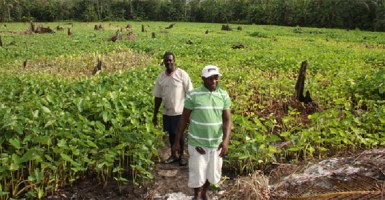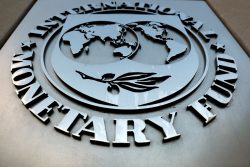Denise Thomas and Eartha Thornhill are second generation residents of the Soesdyke-Linden Highway. They moved there with their parents: Denise, in 1976 at the age of 13 and Eartha in 1973 at the tender age of three. That was a time, they both say, when working-class parents living in inner city areas in the capital were taking advantage of offers being made by the Government of Guyana for people to settle on the Soesdyke-Linden Highway. Both their parents settled at Kuru Kururu.
Thornhill is nostalgic about her childhood days. Her mother planted pineapples; that was her first real taste of farming.
Thomas admits that she is less enthusiastic about the land. She is part of a community initiative that is seeking to whip up enthusiasm for expanding beyond simply growing food. She has a vision of a broader commercial culture that includes processing farm produce into value-added products for sale, both locally and abroad.
Thornhill recalls the days when pineapple was ‘king’ on the highway. In times of glut the community was forced to endure the nauseating smell of rotting pineapples. Thornhill believes there came a point in time when the pineapples simply overwhelmed the communities along the Soesdyke-Linden Highway. The technology with which to process the fruit simply wasn’t there and there was a limited demand for pineapples. She believes that as far as using the development of agricultural settlements on the highway to create a strong agro-processing sector is concerned, Guyana may well have “missed a trick”.

Pineapples are no longer the craze on the Soesdyke-Linden highway. At Kuru Kururu, at least, much of the land is used for cultivating cash crops. The residents have also gravitated towards poultry and pig-rearing. In the swampy backlands, eddo thrives while the land contiguous to the homes of the residents is used mostly for backyard farming.
The real value of backyard farming to the residents of Kuru Kururu reposes in the role it plays as a subsidy for those residents who do full-time jobs. The plots of land that adjoins houses at Kuru Kururu are large and a backyard farm can be a significant earner. The strategic significance of the backyard farm reposes in the fact that it lies close to the home of the owner. There is no time-consuming trek to a farm several miles away and no logistical difficulties like an absence of transportation to move crops from farm to market.
During the working week, Thornhill is a Cyril Potter College of Education-trained primary school teacher. On Sundays she makes the early journey from her home to La Penitence Market with produce from her backyard farm. The produce is seasonal and invariably includes assorted vegetables. Another woman from the community has a stall next to hers. Before midday the produce that she has brought to market is sold out.

The Kuru Kururu Crops and Livestock Association is an umbrella organisation established by the community in September 2007 in an effort to focus its collective attention on making agriculture more profitable. Denise Thomas is the chairperson of the association. Thornhill is its secretary. It is not difficult to discern that, over time, keeping their agricultural ventures alive has been a hard grind for the residents of Kuru Kururu. The primary problem has been a scarcity of financial resources and a consequential failure of their respective enterprises to grow quickly. There is no lack of energy, but the various other limitations are evident.
For example, while the swampy backlands of Kuru Kururu produce thousands of pounds of eddo moving this to market is a formidable constraint. More than that the farmers there have become distrustful of the middlemen, whom, they say, exploit their plight by taking trucks into the area and purchasing the eddo at rock-bottom prices. Once, some years earlier, they had exported a shipment of eddo to Trinidad and Tobago. After they had concluded the transaction with the Trinidadian company in relation to a second shipment they were told that the consignment had spoilt. They were not paid for the consignment even though they were never presented with any evidence of the claims of spoilage. The residents are now less keen to work with overseas buyers.
Slow progress has engendered a measure of frustration. Of the association’s more than 50 members only around half of them are financial members. The others – at least most of them – have become afflicted with a sense of underachievement. Thornhill concedes that some members have grown “tired of talk”. They want to go forward but lack the resources to invest in the infrastructure with which to do so. There is also evidence of a deficiency in direction within the group.

The current focus is on the creation of a value-added culture in their farming pursuits. The association has acquired a large, state-constructed, factory-type building in the community. It is currently being renovated and remodelled to house a number of prospective community enterprises. There is talk of importing a mill to manufacture an assortment of value-added products that could include jams and sauces. In the main, the manufacturing venture appears to be pinning its hopes on utilising the large quantities of eddo cultivated in the community in an experiment that seeks to produce eddo flour.
Over time, some of the residents of Kuru Kururu have been experimenting with the manufacture of eddo flour on a very modest scale. The method of manufacture involves the drying and grinding of the eddo. It has been used in the cooking of various dishes. What the residents of Kuru Kururu do not know is the market potential of the product. It is an experiment that cries out for various forms of official support.
Some measure of support has come from the International Fund for Agricultural Development’s (IFAD) Rural Enterprise and Agricultural Development (READ) project being executed by the Ministry of Agriculture. The association has been the beneficiary of a $4 million grant from READ for the renovation of the building, reportedly a one-time mechanical workshop and a further $1 million loan to help purchase equipment with which to pursue the value-added project.
However, things have not been proceeding apace. The association is now experiencing a protracted wait to have the renovated building served with water and electricity. More than that, the specific ventures which the members intend to pursue, including a decision on the purchase of machinery for the manufacture of value-added products still face some measure of uncertainty.
Years of pursuing agricultural ventures as a means of making a living have thought the members of the association that growth and development are stimulants that provide powerful incentives. Their own experience has been dotted with setbacks and an absence of sustained progress.
Thomas, who grew from a child into an adult at Kuru Kururu acknowledges the role agriculture has played in the development of the community but says its continued growth must be attended by something more. That something more, she says, has to be a programme of diversification into value-added commodities. She is excited about the possibilities eddo flour might offer but concedes that, for the moment at least, it constitutes “an experiment”. To take it forward the stakeholders will have to secure technical help with “the science of the project”. Then there are other considerations like financing the manufacture of the product, its marketing, its packaging and its distribution.
Thornhill, meanwhile, appears to have her feet planted firmly on the ground. She continues to be excited about the prospects which the group’s planned excursion into value-added food crops appears to hold but says that in the meantime she will continue to lend her professional skills to the teaching of children while continuing to pursue backyard farming and the vending of her produce on Sundays. Additionally, she points to the potential among women in the community to develop a sizeable craft market. Part of her hope is that the members of the association and the community as a whole might be granted space off the shoulder of the highway at a location close to their community to set up an open-air market. She believes Kuru Kururu grows sufficient food to sell to other communities as well as to persist with its ambition of becoming one of the country’s focal points for the production of value-added food products.








